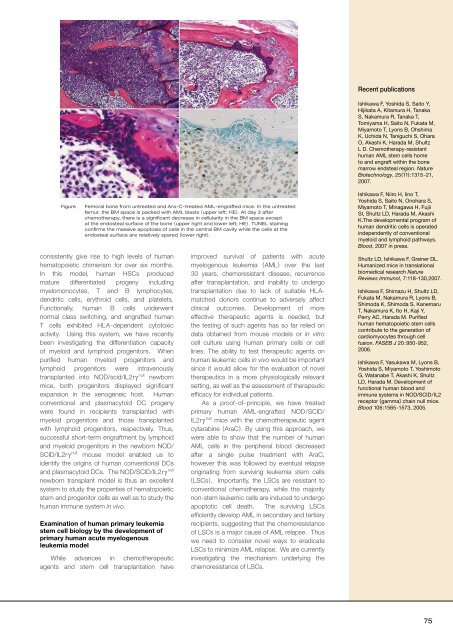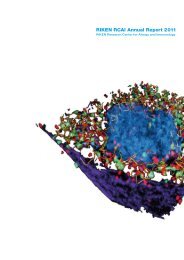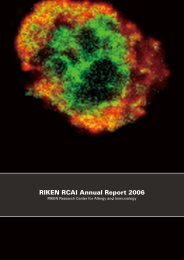in vivo
in vivo
in vivo
Create successful ePaper yourself
Turn your PDF publications into a flip-book with our unique Google optimized e-Paper software.
Recent publications<br />
Ishikawa F, Yoshida S, Saito Y,<br />
Hijikata A, Kitamura H, Tanaka<br />
S, Nakamura R, Tanaka T,<br />
Tomiyama H, Saito N, Fukata M,<br />
Miyamoto T, Lyons B, Ohshima<br />
K, Uchida N, Taniguchi S, Ohara<br />
O, Akashi K, Harada M, Shultz<br />
L D. Chemotherapy-resistant<br />
human AML stem cells home<br />
to and engraft with<strong>in</strong> the bone<br />
marrow endsteal region. Nature<br />
Biotechnology, 25(11):1315-21,<br />
2007.<br />
Figure<br />
Femoral bone from untreated and Ara-C-treated AML-engrafted mice. In the untreated<br />
femur, the BM space is packed with AML blasts (upper left; HE). At day 3 after<br />
chemotherapy, there is a significant decrease <strong>in</strong> cellularity <strong>in</strong> the BM space except<br />
at the endosteal surface of the bone (upper right and lower left; HE). TUNEL sta<strong>in</strong><strong>in</strong>g<br />
confirms the massive apoptosis of cells <strong>in</strong> the central BM cavity while the cells at the<br />
endosteal surface are relatively spared (lower right).<br />
consistently give rise to high levels of human<br />
hematopoietic chimerism for over six months.<br />
In this model, human HSCs produced<br />
mature differentiated progeny <strong>in</strong>clud<strong>in</strong>g<br />
myelomonocytes, T and B lymphocytes,<br />
dendritic cells, erythroid cells, and platelets.<br />
Functionally, human B cells underwent<br />
normal class switch<strong>in</strong>g, and engrafted human<br />
T cells exhibited HLA-dependent cytotoxic<br />
activity. Us<strong>in</strong>g this system, we have recently<br />
been <strong>in</strong>vestigat<strong>in</strong>g the differentiation capacity<br />
of myeloid and lymphoid progenitors. When<br />
purified human myeloid progenitors and<br />
lymphoid progenitors were <strong>in</strong>travenously<br />
transplanted <strong>in</strong>to NOD/scid/IL2rγ null newborn<br />
mice, both progenitors displayed significant<br />
expansion <strong>in</strong> the xenogeneic host. Human<br />
conventional and plasmacytoid DC progeny<br />
were found <strong>in</strong> recipients transplanted with<br />
myeloid progenitors and those transplanted<br />
with lymphoid progenitors, respectively. Thus,<br />
successful short-term engraftment by lymphoid<br />
and myeloid progenitors <strong>in</strong> the newborn NOD/<br />
SCID/IL2rγ null mouse model enabled us to<br />
identify the orig<strong>in</strong>s of human conventional DCs<br />
and plasmacytoid DCs. The NOD/SCID/IL2rγ null<br />
newborn transplant model is thus an excellent<br />
system to study the properties of hematopoietic<br />
stem and progenitor cells as well as to study the<br />
human immune system <strong>in</strong> <strong>vivo</strong>.<br />
Exam<strong>in</strong>ation of human primary leukemia<br />
stem cell biology by the development of<br />
primary human acute myelogenous<br />
leukemia model<br />
While advances <strong>in</strong> chemotherapeutic<br />
agents and stem cell transplantation have<br />
improved survival of patients with acute<br />
myelogenous leukemia (AML) over the last<br />
30 years, chemoresistant disease, recurrence<br />
after transplantation, and <strong>in</strong>ability to undergo<br />
transplantation due to lack of suitable HLAmatched<br />
donors cont<strong>in</strong>ue to adversely affect<br />
cl<strong>in</strong>ical outcomes. Development of more<br />
effective therapeutic agents is needed, but<br />
the test<strong>in</strong>g of such agents has so far relied on<br />
data obta<strong>in</strong>ed from mouse models or <strong>in</strong> vitro<br />
cell culture us<strong>in</strong>g human primary cells or cell<br />
l<strong>in</strong>es. The ability to test therapeutic agents on<br />
human leukemic cells <strong>in</strong> <strong>vivo</strong> would be important<br />
s<strong>in</strong>ce it would allow for the evaluation of novel<br />
therapeutics <strong>in</strong> a more physiologically relevant<br />
sett<strong>in</strong>g, as well as the assessment of therapeutic<br />
efficacy for <strong>in</strong>dividual patients.<br />
As a proof-of-pr<strong>in</strong>ciple, we have treated<br />
primary human AML-engrafted NOD/SCID/<br />
IL2rγ null mice with the chemotherapeutic agent<br />
cytarab<strong>in</strong>e (AraC). By us<strong>in</strong>g this approach, we<br />
were able to show that the number of human<br />
AML cells <strong>in</strong> the peripheral blood decreased<br />
after a s<strong>in</strong>gle pulse treatment with AraC,<br />
however this was followed by eventual relapse<br />
orig<strong>in</strong>at<strong>in</strong>g from surviv<strong>in</strong>g leukemia stem cells<br />
(LSCs). Importantly, the LSCs are resistant to<br />
conventional chemotherapy, while the majority<br />
non-stem leukemic cells are <strong>in</strong>duced to undergo<br />
apoptotic cell death. The surviv<strong>in</strong>g LSCs<br />
efficiently develop AML <strong>in</strong> secondary and tertiary<br />
recipients, suggest<strong>in</strong>g that the chemoresistance<br />
of LSCs is a major cause of AML relapse. Thus<br />
we need to consider novel ways to eradicate<br />
LSCs to m<strong>in</strong>imize AML relapse. We are currently<br />
<strong>in</strong>vestigat<strong>in</strong>g the mechanism underly<strong>in</strong>g the<br />
chemoresistance of LSCs.<br />
Ishikawa F, Niiro H, I<strong>in</strong>o T,<br />
Yoshida S, Saito N, Onohara S,<br />
Miyamoto T, M<strong>in</strong>agawa H, Fujii<br />
SI, Shultz LD, Harada M, Akashi<br />
K.The developmental program of<br />
human dendritic cells is operated<br />
<strong>in</strong>dependently of conventional<br />
myeloid and lymphoid pathways.<br />
Blood, 2007 <strong>in</strong> press.<br />
Shultz LD, Ishikawa F, Gre<strong>in</strong>er DL.<br />
Humanized mice <strong>in</strong> translational<br />
biomedical research Nature<br />
Reviews Immunol, 7:118-130,2007.<br />
Ishikawa F, Shimazu H, Shultz LD,<br />
Fukata M, Nakamura R, Lyons B,<br />
Shimoda K, Shimoda S, Kanemaru<br />
T, Nakamura K, Ito H, Kaji Y,<br />
Perry AC, Harada M. Purified<br />
human hematopoietic stem cells<br />
contribute to the generation of<br />
cardiomyocytes through cell<br />
fusion. FASEB J 20:950-952,<br />
2006.<br />
Ishikawa F, Yasukawa M, Lyons B,<br />
Yoshida S, Miyamoto T, Yoshimoto<br />
G, Watanabe T, Akashi K, Shultz<br />
LD, Harada M. Development of<br />
functional human blood and<br />
immune systems <strong>in</strong> NOD/SCID/IL2<br />
receptor {gamma} cha<strong>in</strong> null mice.<br />
Blood 106:1565-1573, 2005.<br />
75





